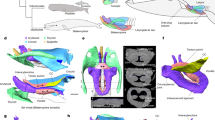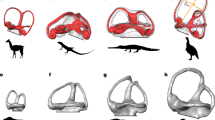Abstract
The origin of whales (order Cetacea) is one of the best-documented examples of macroevolutionary change in vertebrates1,2,3. As the earliest whales became obligately marine, all of their organ systems adapted to the new environment. The fossil record indicates that this evolutionary transition took less than 15 million years, and that different organ systems followed different evolutionary trajectories. Here we document the evolutionary changes that took place in the sound transmission mechanism of the outer and middle ear in early whales. Sound transmission mechanisms change early on in whale evolution and pass through a stage (in pakicetids) in which hearing in both air and water is unsophisticated. This intermediate stage is soon abandoned and is replaced (in remingtonocetids and protocetids) by a sound transmission mechanism similar to that in modern toothed whales. The mechanism of these fossil whales lacks sophistication, and still retains some of the key elements that land mammals use to hear airborne sound.
This is a preview of subscription content, access via your institution
Access options
Subscribe to this journal
Receive 51 print issues and online access
$199.00 per year
only $3.90 per issue
Buy this article
- Purchase on SpringerLink
- Instant access to full article PDF
Prices may be subject to local taxes which are calculated during checkout




Similar content being viewed by others
References
Berta, A. What is a whale? Science 263, 180–181 (1994)
Fordyce, E. & de Muizon, C. in Secondary Adaptation of Tetrapods to Life in Water (eds Mazin, J. -M. & de Buffrénil, V.) 169–233 (Verlag Dr. Friedrich Pfeil, München, 2001)
Thewissen, J. G. M. & Williams, E. M. The early radiations of Cetacea (Mammalia): Evolutionary pattern and developmental correlations. Annu. Rev. Ecol. Syst. 33, 73–90 (2002)
Fleischer, G. Evolutionary principles of the mammalian middle ear. Adv. Anat. Embryol. Cell Biol. 55, 1–70 (1978)
Lancaster, W. C. The middle ear of the Archaeoceti. J. Vertebr. Paleontol. 10, 117–127 (1990)
Oelschläger, H. A. in Sensory Abilities of Cetaceans (eds Thomas, J. A. & Kastelein, R. A.) 137–162 (Plenum, New York, 1990)
Gingerich, P. D., Wells, N. A., Russell, D. E. & Shah, S. M. I. Origin of whales in epicontinental remnant seas: New evidence from the early Eocene of Pakistan. Science 220, 403–406 (1983)
Thewissen, J. G. M. & Hussain, S. T. Origin of underwater hearing in whales. Nature 361, 444–445 (1993)
Nummela, S., Reuter, T., Hemilä, S., Holmberg, P. & Paukku, P. The anatomy of the killer whale middle ear (Orcinus orca). Hear. Res. 133, 61–70 (1999)
Hemilä, S., Nummela, S. & Reuter, T. A model of the odontocete middle ear. Hear. Res. 133, 82–97 (1999)
Hemilä, S., Nummela, S. & Reuter, T. Modeling whale audiograms: effects of bone mass on high-frequency hearing. Hear. Res. 151, 221–226 (2001)
Møller, A. R. in Handbook of Sensory Physiology (eds Keidel, W. D. & Neff, W. D.) Vol. V/1, 491–517 (Springer, Berlin, 1974)
Luo, Z. in The Emergence of Whales (ed. Thewissen, J. G. M.) 269–301 (Kluwer Academic/Plenum, New York, 1998)
Lombard, R. E. & Hetherington, T. E. in The Skull (eds Hanken, J. & Hall, B. K.) 241–302 (Univ. Chicago Press, Chicago, 1993)
Tonndorf, J. A new concept of bone conduction. Arch. Otolaryng. 87, 49–54 (1968)
Nummela, S. Scaling of the mammalian middle ear. Hear. Res. 85, 18–30 (1995)
Hemilä, S., Nummela, S. & Reuter, T. What middle ear parameters tell about impedance matching and high-frequency hearing. Hear. Res. 85, 31–44 (1995)
Wyss, A. R. The walrus auditory region and the monophyly of pinnipeds. Am. Mus. Novit. 2871, 1–31 (1987)
Mason, M. J. Middle ear structures in fossorial mammals: a comparison with non-fossorial species. J. Zool. 255, 467–486 (2001)
Norris, K. S. in Marine Bio-Acoustics (ed. Tavolga, W. N.) 317–336 (Pergamon, Oxford, 1964)
Brill, R. L., Moore, P. W. B. & Dankiewicz, L. A. Assessment of dolphin (Tursiops truncatus) auditory sensitivity and hearing loss using headphones. J. Acoust. Soc. Am. 109, 1717–1722 (2001)
Uhen, M. D. in The Emergence of Whales (ed. Thewissen, J. G. M.) 29–61 (Kluwer Academic/Plenum, New York, 1998)
Luo, Z. & Gingerich, P. D. Terrestrial Mesonychia to aquatic Cetacea: Transformation of the basicranium and evolution of hearing in whales. Univ. Mich. Pap. Paleontol. 31, 1–98 (1999)
Fleischer, G. Hearing in extinct cetaceans as determined by cochlear structure. J. Paleontol. 50, 133–152 (1976)
Ketten, D. R. in The Evolutionary Biology of Hearing (eds Webster, D. B., Fay, R. R. & Popper, A. N.) 717–750 (Springer, New York, 1992)
Thewissen, J. G. M. et al. Evolution of cetacean osmoregulation. Nature 381, 379–380 (1996)
Spoor, F., Bajpai, S., Hussain, S. T., Kumar, K. & Thewissen, J. G. M. Vestibular evidence for the evolution of aquatic behaviour in early cetaceans. Nature 417, 163–166 (2002)
Gingerich, P. D. Land-to-sea transition in early whales: evolution of Eocene Archaeoceti (Cetacea) in relation to skeletal proportions and locomotion of living semiaquatic mammals. Paleobiology 29, 429–454 (2003)
Wagner, G. P. & Schwenk, K. Evolutionarily stable configurations: functional integration and the evolution of phenotypic stability. Evol. Biol. 31, 155–217 (2000)
Nummela, S., Wägar, T., Hemilä, S. & Reuter, T. Scaling of the cetacean middle ear. Hear. Res. 133, 71–81 (1999)
Acknowledgements
We thank E. Blum, K. Grecco and F. Spoor for help with CT scans; W. Lancaster for information about basilosauroid ossicles; M. Filon for artwork; and S. Hemilä, S. Madar, T. Reuter and L. Sundström for commenting on the manuscript. J. Schiebout (Louisiana State University) and H. Baagøe and M. Andersen (Zoological Museum, University of Copenhagen) loaned specimens. The Geological Survey of Pakistan assisted in the collection and loan of some of the fossils. Financial support was provided to J.G.M.T by the National Science Foundation and to S.B. by the Department of Science of Technology of India.
Author information
Authors and Affiliations
Corresponding author
Ethics declarations
Competing interests
The authors declare that they have no competing financial interests.
Supplementary information
Supplementary Figure 1
Rostrolateral view of RUSB 2828, with tympanic. (DOC 515 kb)
Supplementary Figure 2
Rostrolateral view of RUSB 2828, without tympanic. (DOC 737 kb)
Supplementary Figure 3
Ventral view of RUSB 2828, with tympanic. (DOC 739 kb)
Supplementary Figure 4
Ventral view of RUSB 2828, without tympanic. (DOC 722 kb)
Supplementary Data
List of specimens studied for this research.. (DOC 26 kb)
Supplementary Methods
Description of how the drawings in Fig. 1f-g were prepared, and the origin of data presented in Fig. 3. (DOC 19 kb)
Supplementary Table 1
Ossicular masses, tympanic membrane and/or tympanic plate areas for those data points of Fig. 3 for which the numerical values have not been published elsewhere. (DOC 20 kb)
Supplementary Discussion
Background information for the sound transmission mechanisms in odontocetes and mysticetes, in connection to Fig. 2. Additional information as for the systematic relationships in Fig. 4. (DOC 27 kb)
Rights and permissions
About this article
Cite this article
Nummela, S., Thewissen, J., Bajpai, S. et al. Eocene evolution of whale hearing. Nature 430, 776–778 (2004). https://doi.org/10.1038/nature02720
Received:
Accepted:
Issue Date:
DOI: https://doi.org/10.1038/nature02720
This article is cited by
-
The Endocranial Cast of Indohyus (Artiodactyla, Raoellidae): The Origin of the Cetacean Brain
Journal of Mammalian Evolution (2021)
-
Vocal foragers and silent crowds: context-dependent vocal variation in Northeast Atlantic long-finned pilot whales
Behavioral Ecology and Sociobiology (2017)
-
Cranial symmetry in baleen whales (Cetacea, Mysticeti) and the occurrence of cranial asymmetry throughout cetacean evolution
The Science of Nature (2015)
-
Echolocation in Blainville’s beaked whales (Mesoplodon densirostris)
Journal of Comparative Physiology A (2013)
-
Exploring the mammalian sensory space: co-operations and trade-offs among senses
Journal of Comparative Physiology A (2013)




